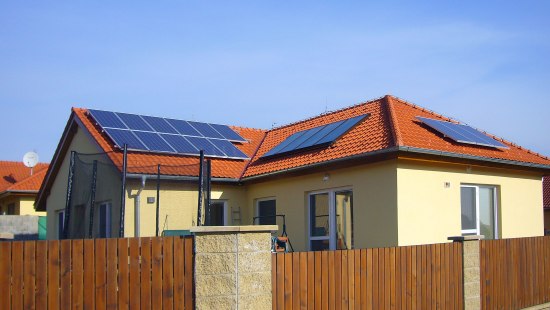Electric heating in an energy-saving detached house – part III

Real experience with heating and its influence on the interior environment of an energy-saving house in Moravany u Brna
In the third part of the series about the construction of an energy-saving house in Moravany u Brna, practical experience with the heating system and the real operating costs in the previous calendar year are described, and also the quality and method of heating is detailed from the point of view of the location of the source. A comparison of the distribution of air temperatures in the vertical plane in a room with floor and ceiling heating was carried out.
Total consumption of electrical energy
As has already been mentioned in the previous articles, there is a combination of large-surface floor and ceiling heating in the building, this being realized with the aid of ECOFLOOR electric heating mats (floors with tiling) and ECOFILM heating foils (floor heating under floating floors and ceiling heating in plasterboard structures); the total installed wattage is 4.5 kW. For the sake of completeness, what are termed "heat gains" - waste heat from appliances, metabolic heat and the exposure of rooms to the sun - is also significant in a passive house.
Obviously, apart from heating, other devices also have a share in the total electricity consumption – home appliances, a boiler for the heating of warm water, lighting, etc. The information that the building is used by six people (3 adults and 3 children) is also important. The house is also fitted with photovoltaic panels, but as the obtained energy is supplied to the power distribution network and isn't used directly in the house, it doesn't have a direct influence on the operating costs – therefore, this equipment isn't described in detail here.
The total consumption of electrical energy under the given conditions and manner of use was 7,540 kWh in the calendar year of 2010 (22.9.2009 – 22.9.2010); in 2010 prices, this amounted to 23,465 CZK including VAT. When calculated per person – the energy costs in the energy-saving REP-HOUSE equalled 3,910 CZK/person/year. Heating only makes up 32% of the total consumption; the rest is made up of other forms of consumption and the heating of warm water. According to the calculations of the author of the project, an associate professor at the Faculty of Civil Engineering at Brno University of Technology, the yearly cost of all energy used would exceed 30 thousand CZK if the building were heated by gas. The main difference would be due to the other consumption of electricity, which wouldn't be operated in the low tariff as is the case for electric heating.
| Period | Consumption in kWh | CZK incl. VAT | |
|---|---|---|---|
| Low Tariff (kWh) | High Tariff (kWh) | ||
| 09/2009 – 09/2010 | 7 065 | 475 | 23 465 |
| 09/2010 – 09/2011 | 5 185 | 576 | 19 028 |
| 09/2011 – 09/2012 | 4 014 | 567 | 16 104 |
| 09/2012 – 09/2013 | 4 817 | 674 | 20 867 |
| 09/2013 – 09/2014 | 4 314 | 682 | 18 148 |
| 09/2014 – 09/2015 | 5 790 | 666 | 17 407 |
Consumption for heating
Thanks to the central regulation from a Czech producer – BMR, based in Rychnov nad Kněžnou – it is possible to separate the electricity consumption for heating, i.e. energy which passes through the heating system of heating foils and mats, from the total consumption of the house – an installed wattage of 4.5 kW. Electricity consumption for heating totals 2.413 kWh, which works out at approximately 7,000 CZK including VAT from the total cost of energy.
An interesting thing is obvious from the graph – "other consumption", i.e. the operation of all the other electric appliances in the household including the lighting, is higher in every month of the calendar year than the energy consumption for heating! This is real-world evidence of the fact that heating isn't the most significant item as far as energy is concerned in current newly built houses.
Practical experience with the heating system
The user is happy with the heating system itself; the whole house is pleasantly warm and yet the source of thermal energy is not obvious – it isn't visible where the heat is coming from as is the case with e.g. standard radiators. With regards to the low-temperature heating system, the structures in which heating is installed behave in a neutral way; this is noticeable mainly in the case of the floors, which are neither warm nor cold – they provide pleasant comfort without drawing the user's attention to their temperature.
The inhabitants of the house had an interesting experience at the end of November 2009 when a technician who was servicing the regulation control of the photovoltaic panels switched off the main circuit breaker of the heating by mistake. Even though the outdoor temperature was only around 0°C and the heating wasn't on, the inhabitants only realized what had happened three days later when the temperature in the house gradually dropped to 19-20°C from the standard 22°C. From this situation, not only the excellent thermal insulation properties of the house are visible but also the effect of what is termed "heat gains", both characteristics being mentioned in the previous part of this trilogy of articles.
Distribution of air temperature in a vertical cross section
In a passive house there is good re-distribution of heat because of the high quality thermal insulation of the exterior of the building. Also, the small warmth requirements and low temperatures involved in large-surface heating enable an even distribution of air temperature to be achieved within the rooms. As customers often ask what the difference between floor and ceiling heating is, the author of the project agreed to carry out measurements of air temperatures for both systems.
The air temperatures were measured within the course of a single day when the heaters (ceiling, floor) were active and in a stabilized state; the measurements were averaged. The measurements were carried out at a height of 200, 160 and 250 cm from the floor in the children's room (ceiling heating) and in the living room (floor heating). The results are shown in the following graph.
Temperature profile of the air during active heating and with switched off ventilation
It is clear from the graph that at a height of 1.6m above the floor the temperature is basically the same for both systems, and that in the case of ceiling heating the temperature directly above the floor (measured at 20cm) is only 0.3°C lower than at a height of 1.6m. The graphs do not provide complete information because there are only a few measuring points and they are too far from one another. A significantly more complete set of measurements was carried out at the testing laboratory at FLEXEL Ltd. (based in Scotland), which is a member of the FENIX holding company.
The test was documented and described in detail on the FENIX web pages in the article Thermal Gradient Of Low Power ECOFILM Ceiling Heating In Low Energy Houses.
Temperatures of the inside surfaces of structures
The temperatures on the surfaces of the wall structures are almost constant and approach the air temperature in the room, i.e. around 22°C. Only in some parts does a lower surface temperature occur, due to a mild thermal bridge. This is where the floor is connected to the terrain with an exterior wall and a window or door frame and jamb (16-20°C). Generally, it is a negligible drop, with the temperature remaining high above dew point and the risk of mold growth.
In conclusion, it can be stated that this method of heating (ceiling and floor) is a very suitable way of heating a passive house. Low-temperature heating is hygienically advantageous; it doesn't dry out the air and stir up dust. It is easy to regulate, so heating energy can be saved and the energy requirements of the building lowered.
You can find the first part of the trilogy here…
You can find the second part of the trilogy here…






